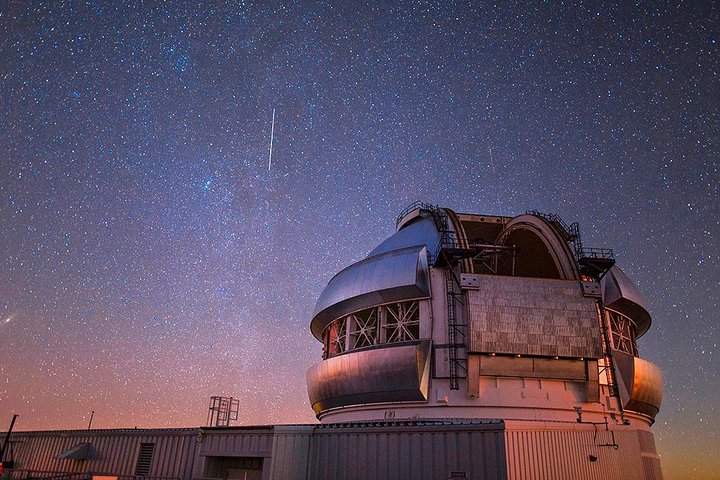Above the Clouds: A Night on Mauna Kea Where Science and Sky Meet
Ride up for sunset, stay for the stars — how to experience Mauna Kea’s rarefied summit safely and respectfully.
By mid-afternoon the road begins to thin. Pine spars give way to ʻaʻā and pāhoehoe, and the air sharpens — not only colder, but thinner, carrying a quiet that feels intentional, as if the mountain itself is reserving a performance. You climb past the Visitor Information Station, a squat, wind-leaning shelter where guides check your group’s readiness and remind you to hydrate. From here the last stretch to Mauna Kea’s summit pushes you into an alpine zone so high and remote the domes of world-class observatories seem to float on a different planet.
Trail Wisdom
Acclimatize at the Visitor Station
Spend the mandatory acclimatization time at the Visitor Information Station — it reduces altitude sickness risk and gives your guide time to brief safety and cultural protocols.
Hydrate Long Before You Go
Begin increasing water intake 24 hours before the tour; thin air and cold both conspire to dehydrate.
Dress in Layers for Rapid Temperature Swings
Bring windproof outer layers plus an insulating mid-layer; summit temps can drop below freezing even after a hot day.
Limit Alcohol and Heavy Meals Pre-Trip
Avoid alcohol and very heavy meals before the ascent to reduce altitude sickness and gastrointestinal discomfort.
Local Knowledge
Hidden Gems
- •Hāpuna Beach State Recreation Area for daytime snorkeling and contrast to the summit
- •On the drive down, stop at the Mauna Kea Ice Age Natural Area Reserve to see ancient cinder cones and native plants
Wildlife
Hawaiian goose (Nēnē) at lower elevations, Native insects and alpine plants adapted to high-elevation conditions
Conservation Note
Visitors are asked to respect archaeological sites and alpine flora, stay on roads and trails, and avoid leaving any trace; follow guidance from the Visitor Information Station and local organizations.
Mauna Kea has long been a sacred site in Native Hawaiian tradition and over the past few decades has also become an international center for astronomical research, a juxtaposition that has shaped local conversations about stewardship.
Seasonal Guide
spring
Best for: Stable skies for stargazing, Cool daytime hiking, Fewer crowds than peak summer
Challenges: Occasional late-night storms, Cold nights
Spring generally offers clear skies and mild days, but nights at altitude can be sharply cold — plan warm layers.
summer
Best for: Extended clear evenings, Warmer daytime temps at lower elevations, Good photography windows
Challenges: Increased tourist numbers, Possible vog from volcanic activity affecting distant visibility
Summer brings reliable skies and longer evenings, though it’s busier and conditions lower down can be warmer than expected.
fall
Best for: Crisp air for vivid skies, Less humidity, Fewer tour groups
Challenges: Variable weather as trade winds shift, Cold nights
Fall can provide some of the clearest conditions for astronomy, but be ready for shifting trade wind patterns.
winter
Best for: Rare snow on summit for dramatic contrast, Exceptional atmospheric clarity on calm nights
Challenges: Potential for snow and ice, Roads may be more difficult, requiring experienced drivers
Winter can be spectacularly sharp and photogenic, but storms and icy conditions raise the stakes — book a guided tour with proper vehicles.
Photographer's Notes
What to Bring
Insulating JacketEssential
A warm down or synthetic jacket protects against summit winds and sub-freezing temperatures.
Sturdy Hiking ShoesEssential
Supportive footwear with good traction handles loose volcanic scree on summit walks.
Tripod
Essential for long-exposure night photography to capture the Milky Way and star trails.
Hydration System (2L+)Essential
Ample water is critical; thin air increases dehydration, so bring more than you think you'll need.
Common Questions
How cold does it get at the summit?
Temperatures can drop below freezing, especially at night; expect wind chill and dress accordingly.
Is altitude sickness common on this tour?
Some participants experience mild symptoms; the tour includes an acclimatization stop and pacing to reduce risk, but stay hydrated and inform guides of any medical concerns.
Can I drive to the summit on my own?
High-clearance 4WD is recommended for the unpaved summit road and some operators require it; many visitors prefer guided tours that handle logistics and safety.
Are the observatory domes open to the public?
Observatory access is restricted; you can view domes from outside and use powerful telescopes during organized viewing sessions, but entering facilities generally requires special permission.
Is stargazing guaranteed?
No — weather and cloud cover determine visibility; reputable operators monitor conditions and may reschedule or issue refunds if the summit is unsafe or visibility is poor.
Do I need any permits to visit Mauna Kea?
No general permit for visitors, but the summit is culturally sensitive — follow all site rules and respect closures; some guided experiences require health and safety waivers.
What to Pack
Insulating jacket, water (2L+), tripod for night shots, sturdy hiking shoes — for warmth, hydration, steady photos, and safe footing
Did You Know
Measured from its base on the ocean floor, Mauna Kea is taller than Mount Everest, with a total height of over 33,000 feet from base to summit.
Quick Travel Tips
Book a guided tour with acclimatization stops; hydrate for 24 hours beforehand; carry layered clothing and a headlamp; check moon phase for best stargazing.
Local Flavor
After the tour, head to Hilo for a local plate lunch and fresh poke, or try a Kona coffee stop on the west side; for local culture, visit a Hawaiian cultural center or farmers market to hear moʻolelo and sample island food.
Logistics Snapshot
Closest airport: Hilo International Airport (ITO). Driving time to Visitor Information Station: ~1–1.5 hours; to summit: ~1.75–2 hours depending on road and weather. Cell service: patchy to none above the Visitor Station. Permits/passes: none required for visitors, but respect cultural sites and any temporary closures.
Sustainability Note
This summit is both ecologically fragile and culturally significant — stick to roads and marked areas, do not remove rocks or artifacts, and dispose of all waste off the mountain.

